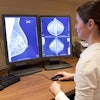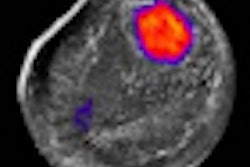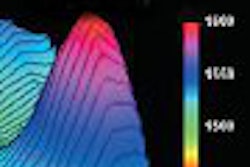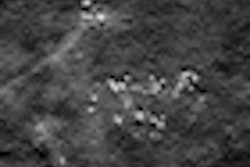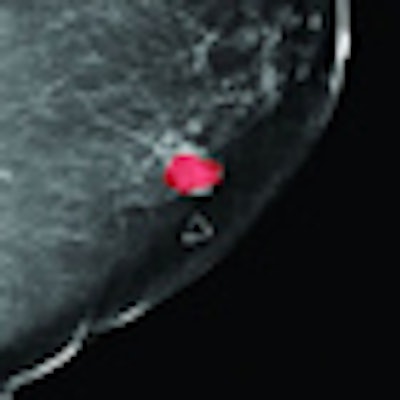
X-ray mammography is the established method for breast cancer screening, with MRI often employed to follow up suspect lesions. But mammography is not perfect: It offers poor contrast in dense breasts, uses ionizing radiation, creates 2D images, and requires breast compression. While MRI circumvents many of these drawbacks, it comes with high setup and operating costs.
These limitations have spurred the development of alternative imaging modalities, several of which were presented at the SPIE Medical Imaging meeting held in February in Lake Buena Vista, FL.
One emerging breast imaging modality is ultrasound tomography, which can generate 3D images of the speed of sound in tissue. As a high speed of sound is expected to be indicative of cancerous structures, the technique offers the potential for tissue characterization and early tumor detection. But as Torsten Hopp, a doctoral student at Karlsruhe Institute of Technology in Germany, explained, there's no experience yet in using ultrasound tomography for clinical diagnosis.
Hopp and colleagues therefore developed a means to evaluate the clinical applicability of speed of sound images, via comparisons with corresponding x-ray mammograms. The method -- which involves registration of images from the two modalities -- could also prove of diagnostic benefit by adding speed of sound information to mammograms.
Combining the different images, however, is challenging. Mammograms show 2D projections of a compressed breast, while speed of sound images are 3D and recorded with the uncompressed breast in prone position. To enable accurate registration, the researchers used the finite element method to simulate the breast compression in the mammogram, and then applied this compression to deform the speed of sound image.
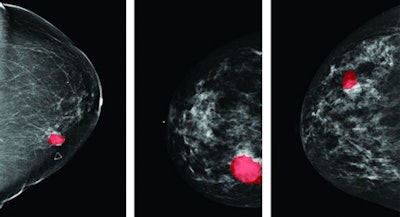 |
| Three cases of the highlighting of tumors in an x-ray mammogram by using speed of sound thresholds. Data provided by the Karmanos Cancer Institute and Delphinus Medical Technologies. |
To evaluate the accuracy of this method, they compared breast lesion location as defined by the two imaging modalities in 15 clinical datasets. With fully automated registration, the mean displacement of the lesion center was 12.8 mm and the mean lesion overlap was 83%. Using manual corrections to account for patient positioning, the mean displacement reduced to 7.1 mm while the mean overlap increased to 91%. "The speed of sound overlays line up well with lesions that are visible in mammography," said Hopp.
The researchers have developed a semitransparent overlay to display the maximum intensity projection of the deformed speed of sound image directly on the mammogram. This should enable effective visualization of speed of sound properties, and thus breast tissue type. Over the 15 datasets, the mean speed of sound threshold required to distinguish the lesion from surrounding tissue was 1,520 m/sec. "We can distinguish the lesion and surrounding tissue in all cases," said Hopp.
He also noted that changing the threshold value enables different tissue types to be distinguished, with approximate thresholds of 1,350 to 1,450 m/sec highlighting fatty tissue, 1,450 to 1,500 m/sec highlighting glandular tissue, and above 1,500 m/sec visualizing tumor.
MR comparison
Dr. Peter Littrup, a radiologist with the Karmanos Cancer Institute (KCI) of Wayne State University, also discussed the application of ultrasound tomography to breast imaging, suggesting that the technique could prove a worthy replacement for MRI by offering similar imaging quality at far lower costs. "MRI has become the imaging gold standard, particularly for high-risk women, but for the general population, it's too expensive for repeat screening," he told the SPIE delegates.
 |
| The SoftVue prototype with two of its co-creators, Peter Littrup (left) and Neb Duric. Image credit: David Dalton. |
The goal for the commercial product, noted Littrup, is to scan five patients per hour -- a throughput that rivals that of digital mammography.
As well as speed of sound imaging, SoftVue also simultaneously records reflection and attenuation images. The current spatial resolution (for 5-mm slice thickness) is 0.5 mm for reflection mode, and 2 mm for speed of sound and attenuation modes. The commercial prototype, which is expected to be available in 2012, will have less than 1-mm resolution in all planes to rival MR multiplanar formatting.
The researchers have developed a method to fuse the three tomographic images together, employing variable thresholds to enable multiparameter visualization of breast tissue. In the fused image, reflection data are shown in grayscale, and speed of sound data above a threshold of 1,520 m/sec are overlaid in yellow. Overlaying of the attenuation image, with regions highlighted in red where both speed and attenuation thresholds are met, displays cancerous regions.
Littrup presented results from an ongoing study comparing ultrasound tomography and MRI in 36 patients. Qualitative and quantitative assessments of the images revealed the two modalities to show strikingly similar representations of a patient's breast anatomy. Ultrasound tomography showed a similar ability to T1 MRI to identify cysts, while benign solid masses were visualized much more clearly.
As well as lesion detection, SoftVue is also being promoted for use in treatment monitoring, to track patients' response to chemotherapy or needle-guided ablation, for example. Again, while MRI could perform this task admirably, its use is limited by high costs.
Photoacoustic option
Another modality under consideration for breast imaging is photoacoustic tomography. Robert Kruger, PhD, president and co-founder of OptoSonics, described the company's development of a photoacoustic tomography system for breast imaging. "Photoacoustic imaging is mostly preclinical, but we're at the point where we have the ability to translate," he said.
The prototype photoacoustic tomography scanner is based on a hemispherical array of 128 ultrasound transducers spaced over the surface of a 100-mm radius bowl. Each transducer has a diameter of 3 mm and the breast is suspended in water within the bowl. Pulsed near-infrared (800 nm) laser light is incident upon the breast via an aperture at the bottom of the bowl.
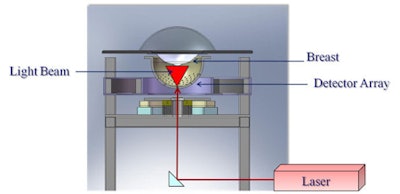 |
| Schematic of the photoacoustic tomography scanner, showing the laser incident on the breast, which is suspended within the hemispherical transducer array. |
The light pulses induce thermal expansions that generate acoustic waves, which, in turn, are detected by the transducers. During image acquisition, the bowl rotates while the breast is immobilized. The system can record images at 240 angles in 24 seconds, with the tomographic image reconstructed using filtered back projection.
The scanner, which offers a spatial resolution of 280 µm, has demonstrated 3D visualization of submillimeter-sized blood vessels to a depth of 40 mm, without the use of contrast agents. This suggests that the technique could be suitable for detection of breast-cancer-stimulated angiogenesis.
"In the breast, optical absorption due to hemoglobin is about 20 times greater than absorption in the rest of the breast," said Kruger. "This implies that there's a potential for high signal-to-noise imaging of anything containing hemoglobin. Breast neoplasms that contain hemoglobin should be detectable."
OptoSonics' photoacoustic detector array can also be used to create 3D ultrasound images, by replacing the laser with a pulsed ultrasound transducer -- a technique dubbed integrated backscatter ultrasound (IBUS). Kruger noted that tests on a wire-containing phantom demonstrated good spatial resolution imaging.
One envisioned application of IBUS is for detection and characterization of microcalcifications in the breast. Kruger and colleagues imaged a microcalcification phantom using conventional B-mode ultrasound and IBUS. Images recorded using IBUS had three to five times better spatial resolution than B-mode images, detecting microcalcifications as small as 100 to 200 µm.
Future work will involve increasing the field-of-view to image the entire breast. "We're at 40 mm now, and we believe we can get to a depth of 75 mm," said Kruger. Other developments may include the implementation of dynamic scanning, and integration of photoacoustic and IBUS imaging into one platform.
© IOP Publishing Limited. Republished with permission from medicalphysicsweb, a community website covering fundamental research and emerging technologies in medical imaging and radiation therapy.



